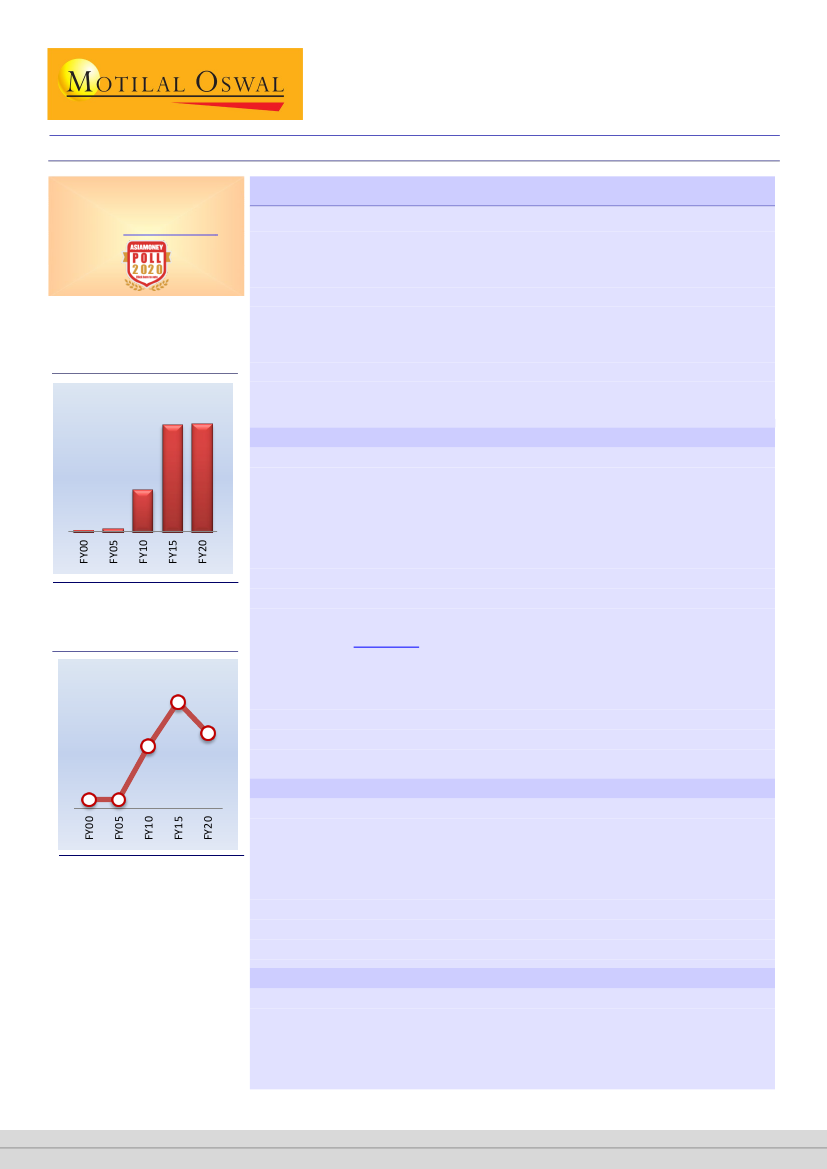
23 June 2020
India Strategy
BSE Sensex: 35,430
Motilal Oswal values your support in
the Asiamoney Brokers Poll 2020 for
India Research, Sales and Trading
team. We
request your ballot.
S&P CNX: 10,471
Indo-China Conflict: A look at sectoral inter-linkages with China
Pharma, Auto, Consumer Durables, Telecom Equipment most exposed
Trade Deficit with China (USD b)
48.5 48.6
The recent border conflict with China in the Galwan valley of Ladakh is
unprecedented and has heightened geopolitical tensions. This has caused significant
backlash in India.
Further, the narrative of reducing trade dependence on China is gaining steam.
In this report, we look at key India-China macro trade metrics and highlight sector-
wise exposure to China on imports, supply-chains and raw materials.
India's trade deficit with China has doubled in the last decade. From sectoral
perspective, Pharma, Consumer Durable, Telecom Equipment and Automobiles will
be relatively more impacted along with a spill-over to stringent trade policy
actions/retaliations if the India-China conflict escalates further.
Unprecedented geopolitical flare-up in Indo-China relations
19.2
0.8 1.5
Trade Deficit with China (% of
GDP)
2.4
1.7
1.4
0.2 0.2
The recent (15-16
th
Jun’20) flare-up on the Indo-China border in the Galwan Valley
of Ladakh is unprecedented. It has heightened geopolitical tensions between the
two nations leading to reports of potential escalation. The situation is currently
fluid with diplomatic and political emphasis on disengagement and a desired return
to normalcy at the earliest. However, these events have caused significant backlash
in India, giving rise to a narrative of reducing dependence on China – both on
business and commercial fronts. Media reports suggest that the Government of
India has asked the industry to prepare a list of products imported from China; this
would help identify non-essential imports for which local substitutes could then be
made available (Refer
here).
Further, business contracts awarded to Chinese firms
have been cancelled by some state governments (Maharashtra and Haryana). While
we would not like to hypothesize on the possible future steps being contemplated,
in this note we look at key macro trade parameters between India and China and
the inter-linkages of different sectors with China in terms of sales, supply chains as
well as investments. Moreover, we have also highlighted sectors and companies,
which would get impacted in case of import curbs or tariffs.
Snapshot of key macro trade metrics between India-China
From barely any deficit in FY00, India ran a trade deficit of USD48.6b (1.7% of GDP)
with China in FY20. India’s imports from China have risen steeply from just 2.6% of
total imports in FY00 to an all-time high of 16.4% in FY18 before easing to 14%
(USD65.3b) in FY20. India’s exports to China, as a percent of total exports, have just
started picking up pace after touching 3.4% in FY16. In FY20, it stood at USD16.6b
or 5.3% of total exports from India. Finally, as per official data from the Department
of Industrial Policy and Promotion (DIPP), China’s FDI inflow over FY00-20 to India
stood at a mere USD2.4b out of India’s total FDI inflow of USD470.1b.
Several sectors have material linkages with China
From a sectoral perspective Auto, Consumer Durables, Pharmaceuticals, Telecom,
Chemicals and Renewable Power sector (Solar) seem to be the most dependent in
terms of sourcing from China. Also, in many cases there appears to be a lack of
alternative suppliers at the same scale or costs. While Consumer Durables is
dependent on China for components, Pharma is dependent for API sourcing.
Research Analyst: Gautam Duggad
(Gautam.Duggad@MotilalOswal.com); +91 22 6129 1522;
Nikhil Gupta
(Nikhil.Gupta@MotilalOswal.com); +91 22 6129 1555
May 2020
Yaswi Agarwal
(Yaswi.Agarwal@motilaloswal.com); +91 22 7193 4196;
Jayant Parasramka
(Jayant.Parasramka@motilaloswal.com)
1
Motilal Oswal research is available on www.motilaloswal.com/Institutional-Equities, Bloomberg, Thomson Reuters, Factset and S&P Capital.
Investors are advised to refer through important disclosures made at the last page of the Research Report.